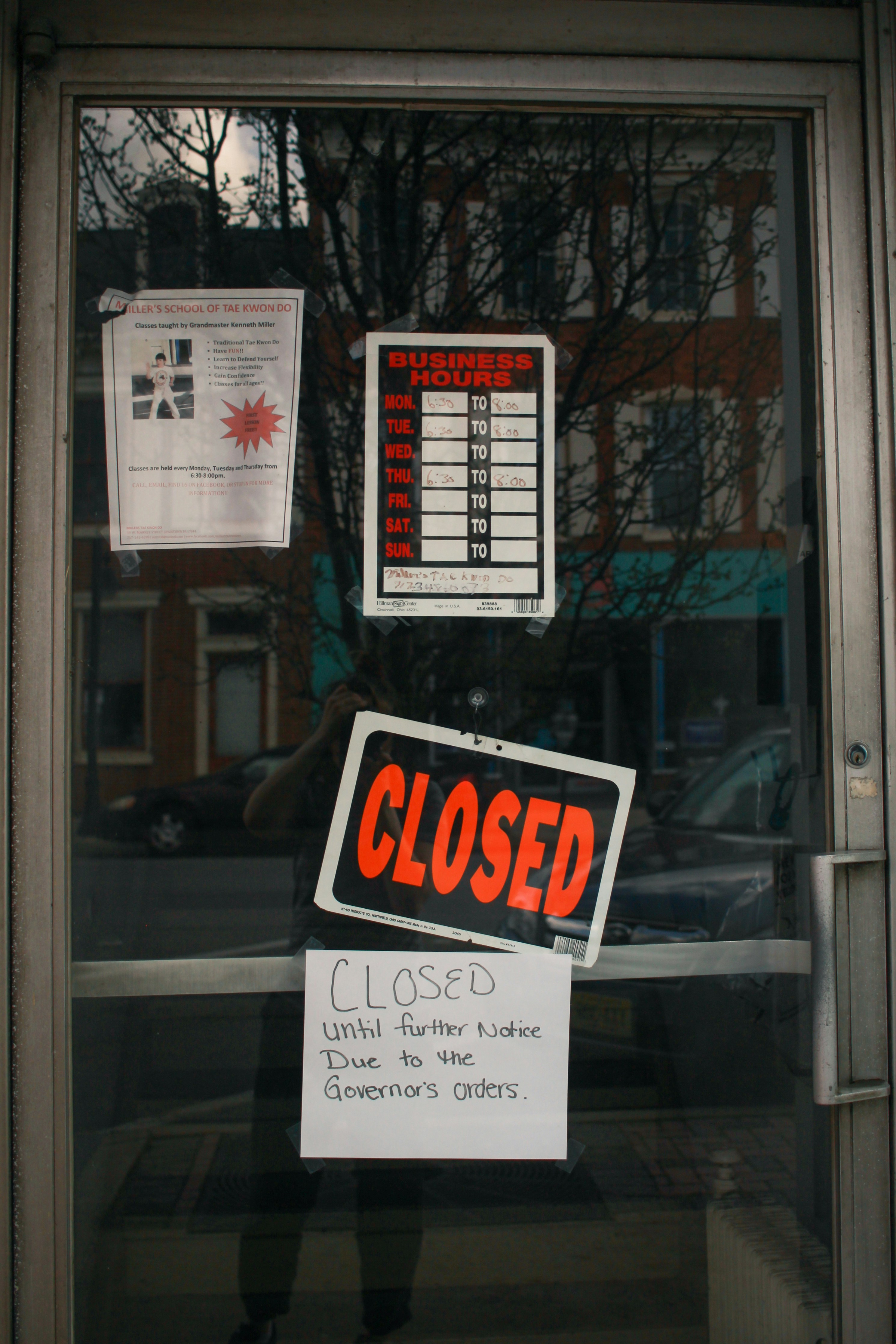The Economic Decline
The recent announcement of a 0.3% contraction in the U.S. economy for the first quarter has raised significant concerns among economists, policymakers, and business leaders alike. Economic contraction refers to a decline in a country’s gross domestic product (GDP), indicating that the overall economic activity is decreasing. This decline can be a key indicator of economic distress, leading to various implications for employment, consumer spending, and business investment. Understanding the reasons behind this contraction is critical, as it provides insight into the health of the economy and the factors that could potentially exacerbate or alleviate the situation.

Several elements contribute to this contraction, including external market pressures, changes in consumer confidence, and shifts in business investment, often linked to policy uncertainties. In recent times, business leaders have expressed apprehension regarding the evolving landscape of U.S. economic policy, particularly under the Trump administration. This uncertainty can lead to reluctance from businesses to expand operations or invest in new projects, as they remain cautious of future regulations and trade conditions. Such hesitancy inevitably contributes to slower economic growth, marking a period where the economy struggles to maintain momentum.
The implications of a contracting economy can be far-reaching. As businesses scale back operations or delay investments, job creation may stall, leading to higher unemployment rates. Additionally, consumer spending, which accounts for a significant portion of economic activity, may also decline as households grapple with financial uncertainty. The ripple effects of this contraction can be felt across various sectors, underscoring the urgency for a comprehensive analysis of current economic policies and their impacts. Ultimately, understanding these dynamics is essential for developing effective strategies to stimulate economic recovery and promote sustained growth moving forward.
Understanding Economic Contraction
Economic contraction refers to a decline in a nation’s output as measured by the Gross Domestic Product (GDP) over a specified period, typically two consecutive quarters. Indicators of economic contraction include reduced consumer spending, decreased business investment, rising unemployment rates, and shrinking industrial production. These signals can often serve as precursors to a more profound economic downturn, prompting vigilance from policymakers, businesses, and consumers alike.
Several factors can trigger economic contraction. Among these are external shocks, such as a sudden increase in energy prices, trade tensions, or shifts in global economic conditions. Additionally, internal dynamics, including policy uncertainty, inflationary pressures, and supply chain disruptions, can create a challenging environment for businesses. In recent years, the uncertainty surrounding various governmental policies, especially those implemented during the Trump administration, has contributed to fluctuating business confidence, thereby influencing investment decisions and expenditure patterns.
The implications of economic contraction are substantial and multifaceted. In the short term, businesses may respond to declining demand by reducing their workforce or halting expansion plans, leading to increased unemployment rates. This, in turn, diminishes consumers’ purchasing power, further exacerbating the downward cycle. In the long term, prolonged economic contraction can hinder investments in infrastructure and innovation, resulting in diminished economic growth potential. Consequently, the overall economic landscape can shift, impacting future consumer confidence and spending habits.
Understanding the intricacies of economic contraction helps stakeholders anticipate possible effects on employment and investment. Such awareness is crucial for adapting strategies to navigate the cyclical nature of the economy, thereby fostering resilience in both business operations and consumer behavior.
Exploring Trump Administration Policies
During the Trump administration, several key economic policies were enacted that significantly influenced the business landscape in the United States. These policies primarily encompassed tax reforms, trade policies, and efforts toward deregulation. Each of these facets played a crucial role in shaping the investment climate and overall business confidence during this period.
One of the hallmark initiatives of the Trump administration was the Tax Cuts and Jobs Act of 2017, which aimed to lower corporate tax rates and stimulate economic growth. By reducing the corporate tax rate from 35% to 21%, the intention was to provide businesses with more capital for reinvestment, thereby creating jobs and driving innovation. However, the uncertainty surrounding how companies would respond to these tax incentives impacted their investment decisions. Some businesses took advantage of the tax cuts to repatriate foreign profits, while others adopted a more cautious approach, unsure of the long-term sustainability of such policies.
In addition to tax reforms, Trump’s trade policies, including imposing tariffs on imports, particularly from China, led to a significant shift in the trade environment. The administration promoted an “America First” approach, which aimed to protect domestic industries. However, this resulted in retaliatory tariffs from other countries, causing uncertainty in supply chains and affecting manufacturing sectors dependent on global trade. Businesses faced challenges in adapting to the changing landscape, ultimately affecting their planning and investment strategies.
Deregulation was another key strategy undertaken by the Trump administration, which sought to reduce the regulatory burden on businesses. While proponents argued that rolling back regulations would enhance competitiveness, critics contended that this increase in deregulation brought about unpredictability, particularly in sectors like environmental protection and healthcare. This uncertainty made it difficult for businesses to anticipate future costs and comply with potential regulatory shifts, further impacting their long-term investment outlook.
Impact of Political Uncertainty on Businesses
The relationship between political uncertainty and economic performance has been a topic of considerable discussion among economists and business leaders alike. Political uncertainties often emerge from fluctuating governmental policies, leadership changes, and unpredictable legislative actions. Such uncertainties can lead to an environment where businesses become hesitant to make significant financial decisions. This indecision frequently manifests in the form of stalled investment strategies and restrained hiring practices, ultimately impacting overall economic growth.
One primary way political uncertainty affects businesses is through the disruption of long-term planning. When companies are unsure about future regulatory changes or tax implications, they tend to adopt a cautious approach. This cautiousness can deter capital investment in new projects or expansion plans, leading to a stagnation in economic activity. For example, if a corporation is contemplating whether to launch a new product, the potential threat of new tariffs or compliance regulations may force them to delay or forgo the investment entirely.
Moreover, the employment landscape can be significantly affected by political uncertainties. Companies may choose to freeze hiring or scale back on payroll expansions if they are uncertain about future economic stability. This results in a ripple effect that can contribute to higher unemployment rates and decreased consumer spending. For instance, if businesses are preoccupied with the ambiguity surrounding national policies, they may deprioritize efforts to recruit talent despite having vacancies that could stimulate productivity and innovation.
In essence, the indecision stemming from political uncertainty creates a climate that not only hinders immediate opportunities for growth but also diminishes overall business confidence. As firms remain wary of committing resources due to unpredictable policy directions, the potential for a slowdown in economic activity is inevitable. The interplay between policy uncertainty and business performance highlights the significance of a stable political environment in fostering economic vitality.
Sector-Specific Analysis of the Contraction
The contraction of the US economy by 0.3% in the first quarter can be attributed to various factors affecting key sectors. Among the industries, manufacturing has experienced one of the most significant declines. Uncertainty surrounding trade policies and tariffs, particularly those introduced during the Trump administration, has led to hesitancy among manufacturers to invest in new projects. As a result, production levels fell, contributing substantially to the overall economic contraction. Furthermore, the ongoing supply chain disruptions have exacerbated challenges in this sector, forcing many manufacturers to reassess their operational strategies.
The services sector, which constitutes a substantial part of the US economy, has also felt the adverse effects of economic uncertainty. Businesses in the hospitality, travel, and entertainment domains report reduced consumer spending due to ambiguous policy directions. Factors such as changing regulations and fluctuating consumer confidence have led to fewer bookings and reduced foot traffic. This sector’s struggles reflect a broader trend of anxiety that permeates various service-oriented businesses. Recovery in this area will depend heavily on stabilizing consumer sentiment and the reestablishment of regular travel and leisure activities.
In contrast, the agriculture sector has shown resilience amid the economic slowdown, but it too faces challenges attributed to policy ambiguity. Tariff measures and shifting international trade agreements significantly influence the agricultural market. Farmers have been wary of exporting their products, leading to reduced sales and market instability. Moreover, adverse weather conditions have compounded these issues, leading to concerns over crop yields and overall productivity. In summary, the contraction of the US economy is a culmination of various challenges across these sectors, driven by the uncertainties resulting from Trump-era policies that have had lasting impacts on the business environment.
Consumer Confidence and Spending Trends
Consumer behavior is a fundamental driver of economic activity, particularly during periods of contraction, such as the 0.3% shrinkage observed in the first quarter of this year. This downturn has been closely linked to an increase in policy uncertainty stemming from the previous administration’s stance on various economic issues. As businesses grapple with the unpredictability of regulations and legislation, consumer confidence tends to wane. When consumers perceive instability in policy direction, they often adjust their spending habits accordingly, adopting a more cautious approach.
Research consistently indicates that consumer confidence correlates strongly with spending. When consumers feel optimistic about their financial situation and the broader economic outlook, they are more inclined to make significant purchases, contributing to overall economic growth. Conversely, during times of uncertainty, such as the current economic climate shaped by Trump-era policy uncertainties, individuals tend to prioritize savings over expenditures. This shift can lead to reduced consumer spending, which, in turn, negatively impacts businesses relying on steady demand.
Moreover, this behavioral shift is particularly evident in sectors sensitive to discretionary spending, such as retail and hospitality. As households become more frugal, businesses may see decreased revenue, prompting them to reevaluate their investment strategies. This cautious approach to spending not only hampers immediate economic activity but may also instill a long-term culture of conservatism among consumers, ultimately affecting future growth prospects.
In summary, the relationship between consumer confidence and spending trends showcases the significant impact of policy uncertainty on economic behavior. The contraction in the economy is indicative of broader ramifications as consumers navigate a landscape marked by unpredictability. In effect, fostering an environment of clear and stable policies may enhance consumer sentiment, encouraging more robust spending and contributing positively to economic recovery.
Response from Financial Markets
The contraction of 0.3% in the US economy during the first quarter has prompted varied responses from financial markets. Stock markets generally reacted with caution, as investors digested the implications of the economic slowdown. Major indices, such as the S&P 500 and Dow Jones Industrial Average, experienced fluctuations throughout the reporting period. On days when data indicated stronger fundamentals in other sectors, these indices often rebounded, showcasing the markets’ inherent volatility amidst uncertain economic conditions.
Quantitatively, trading volumes increased during this period, suggesting a heightened level of investor engagement and concern. Investors may have been recalibrating their expectations regarding earnings growth and economic recovery amid the uncertainty brought about by policy decisions. This scenario reflects a broader trend where financial markets are significantly influenced by real-time economic metrics, alongside investor sentiment and speculation regarding future fiscal policy.
The bond market also displayed notable movements in response to the contraction. Yields on U.S. Treasury bonds shifted as investors sought safety amid fears of a prolonged economic slowdown. The demand for government bonds typically increases during uncertain times, causing yields to fall as prices rise. Consequently, this shift indicates that investors are not only vigilant of current economic indicators but are also concerned about future risks tied to policy uncertainties and their potential impact on overall growth.
Moreover, the contraction has contributed to a palpable sense of unease among investors, leading to shifts in sentiment that can influence funding costs for businesses. Market participants have been closely monitoring central bank responses, including any changes in interest rates that may arise in reaction to economic data. Thus, the feedback loop between investor perceptions and market dynamics remains critical in understanding the broader economic context and its implications.
Historical Context and Comparisons
The contraction of 0.3% in the U.S. economy during the first quarter of the year marks a significant moment when comparing historical economic downturns. Economic contractions are not new to the U.S., with several prominent instances in recent history serving as valuable reference points. For instance, the recession of 2008, triggered by the collapse of the housing market and a subsequent financial crisis, resulted in a severe GDP decline. However, the contraction during the first quarter of this year appears to have been influenced heavily by ongoing uncertainties surrounding government policy, particularly those associated with the previous administration, led by President Trump.
During past recessions, government responses have played crucial roles in shaping the economic landscape. In 2008, federal stimulus packages and quantitative easing were deployed to stabilize the economy, ultimately fostering recovery. Comparatively, the current economic climate has been complicated by mixed signals from policy changes that have left businesses uncertain about future regulations and trade relationships. The trade tensions initiated during Trump’s tenure, including tariffs on imports, resulted in increased costs for manufacturers and consumers alike, thereby contributing to this latest contraction.
Moreover, the COVID-19 pandemic introduced a layer of complexity that was absent in previous economic challenges. Unlike earlier instances of economic difficulties, which were often confined to specific sectors or industries, the pandemic’s widespread impact required more holistic and immediate policy responses. As the economy now grapples with the repercussions of such uncertainty, it is essential to understand how historical contexts shed light on today’s challenges. By examining past instances of economic decline, we can better comprehend the intricate relationships between government policy, business confidence, and economic performance.
Looking Ahead: Predictions and Recommendations
As we contemplate the future trajectory of the U.S. economy, it is crucial to understand the prevailing uncertainties shaped by the policies of the Trump administration. The recent contraction of 0.3% in the first quarter underscores the vulnerabilities that businesses face in a climate marked by political indecision and fluctuating economic policies. Analysts predict that without clear guidance and consistency from policymakers, many industries may continue to experience turbulence in the upcoming quarters.
One potential trend that could emerge is an increased focus on regulatory stability. Businesses, particularly those reliant on exports and international trade, may seek clarity on trade policies that directly influence their competitive landscapes. It is advisable for companies to engage with policymakers to advocate for a more stable and predictable regulatory environment. This engagement not only fosters relationships but also allows businesses to voice their concerns and recommendations, potentially guiding future legislative action.
Moreover, another recommendation for businesses is to adopt adaptive strategies to manage risks associated with ongoing policy changes. This may involve diversifying supply chains, investing in technology that enhances operational efficiency, or exploring alternative markets that may be less affected by domestic policy uncertainty. By proactively adjusting to these dynamics, companies can mitigate the potential negative impacts of economic fluctuations.
For policymakers, fostering open communication with the business community is essential. Stakeholders should prioritize listening to the concerns of various sectors and strive to craft policies that promote economic resilience. Furthermore, investing in infrastructure and workforce development can serve as a foundation for sustained growth, regardless of the political landscape. By addressing these areas, both businesses and policymakers can navigate the uncertain economic environment more effectively, setting the stage for recovery and growth in the future.





















I’ve used tyy.AI Tools to streamline my workflow, and it’s a game-changer for finding the right AI tools. The AI Facebook Assistant is a standout for social media efficiency. Love how they keep everything organized!